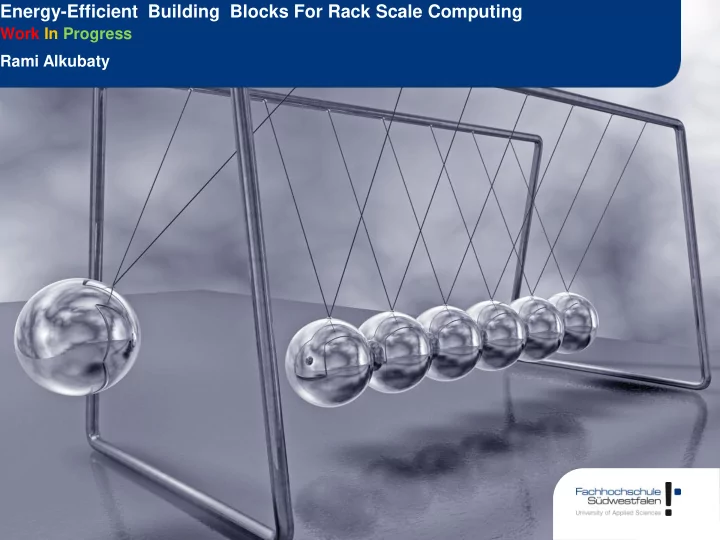

Energy-Efficient Building Blocks For Rack Scale Computing Work In Progress Rami Alkubaty
Contents Motivation Approach Initial Experiments and First Insights Next Steps Slide 2
Motivation Rack scale systems are present or will be present in various business domains Various requirements Energy efficiency Performance Cost …and many others Various load characteristics from very static to highly fluctuating Image: http://www.techrepublic.com Slide 3
Motivation: Our Focus Unit of consideration: The rack It gets load from customers, or datacenter coordinator We consider scenarios with Highly fluctuating load Individual target requirements High performance Energy efficiency Different tradeoffs between energy and performance Dynamic changes of these requirements Slide 4
Approach: High Level Tasks associated with information about energy-performance trade-off Two-level control system: Rack controller: coarse grained load distribution Node Controller: fine grained decision how to deal with load Feedback channel: reports on load-status “evaluates” RC decision FOCUS: NODE Slide 5 -
Approach: Heterogeneity Heterogeneity is the way to go! Rack: different computers We are NOT considering this Node: heterogeneous processors having the same ISA (Instruction Set Architecture) Slide 6 -
Approach: Challenge How to use heterogeneous processors efficiently? There is no magic receipt! Analysis (Statistical, heuristic ,…)? No, our approach considers the system as a black-box Slide 7 -
Approach: Black Box Black box can be realized by the means of Machine Learning Using Machine Learning means we need to: - know if patterns exist if so: - acquire data - build mathematical model Data Acquisition: Performance Monitoring Counters (PMCs) (and Energy measurements) Mathematical Model: Unsupervised Learning (later on!) Slide 8 -
Approach: Summary We think: i) Tackling energy-efficiency & performance tradeoff with CPU heterogenity (same ISA) within the node ii) Considering systems (also Rack Scale Systems) as black box to decouple diversity & rapid development Slide 9
Initial Experiments And First Insights Bear in mind this work still in progress! We are still in the very early phases where we are trying to find out if this works! Our work is inspired by (but not based on): Josep LI. Berral et. al., 2010 “ Towards energy- aware scheduling in data centers using machine learning” Matthew J. Walker et. al. 2016 “Accurate and Stable Run -Time Power Modeling for Mobile and Embedded CPUs ” A. Weisel, F. Bellosa, 2002 “Process cruise control: event -driven clock scaling for dynamic power management ” Slide 10
Initial Experiments And First Insights Experiments: + Hardkernel Odroid xu4 (image: http://hardkernel.com) Slide 11
Initial Experiments And First Insights Slide 12 -
Initial Experiments And First Insights Huge data samples. Empirical analysis does not show the insights all the time. We rely on ML Slide 13 -
Initial Experiments And First Insights WE need to observe how PMC behave when apply different on the system Is PMCs grouping possible? Is it unique? What is the system status thereby? sytemStatus = f(MPCs) Clustering? ML helps, specifically Unsupervised Learning Slide 14 -
Initial Experiments And First Insights Unsupervised Learning Contrary to Supervised Learning we do not need trained labeled dataset In unsupervised learning we are trying to draw inferences from unlabeled dataset SL Classification, USL Clustering (KNN: K Nearest Neighbors) D1= [ a1, b1, c1] D2= [ a2, b2, c2] ….. Dn=[an, bn, cn] Slide 15 -
Initial Experiments And First Insights Unsupervised Learning How this would look like? An overview (rather a very simplified one in 2D) We consider the case when the system is lightly unloaded N-dataset of PMCs readings c1 = [r11, r12] c2 = [r21, r22] ….. cn = [rn1, rn2] rx1 = counter’s reading per million cycles when running CPU bound application. rx2 = counter’s reading per million cycles when running memory bound application Slide 16 -
Next Steps We continue developing the approach: adding energy measurements to the existing set of experiments. using more complex benchmarks with known but fluctuating behavior. developing ML model Evaluation and comparison to related works Eventually , we will be glad to present the results in “ Herbsttreffen 2017”! Beyond this step, if results are found promising we will delve into sophisticated techniques like “Reinforcement learning”. Slide 17
Recommend
More recommend